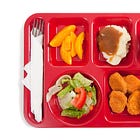The Burnt Toast Guide to Diet Culture in Schools
Anti-fat bias in cafeterias, curriculums, and classroom culture. And: Introducing Extra Butter!
ICYMI, BT Guides are a new recurring series where I dig into your most frequently asked questions. Here’s the first one, on weight and health, and the second one, on talking to kids about anti-fat bias.
BT Guides are a free resource, but if you find them valuable, please consider supporting this work with a paid subscription. You can join for just $5 per month (or $50 for the year).
Or you can upgrade to our new Extra Butter tier for $10 per month.
Extra Butters are going to get a bunch of… extra butter, starting with a monthly live AMA thread, where we can hang and chat about literally anything you want. Our first live thread will be tomorrow (Wednesday September 13) from 8-9pm Eastern. If you can’t make it (I know, I know, time zones!) but have a question to ask, you can drop it here and catch up on the thread later.
I’ll make this live thread available to all paid subscribers so we can test it out together. (Don’t worry, you’ll get an email when we’re ready to start.) Starting next month, this will be an Extra Butter perk only — join now so you don’t miss out!
PS. If you were already a “founding member,” you’ve been automatically converted to Extra Butter status! Thank you!
How (And Why) Does Diet Culture Show Up At School?

1. In the Cafeteria
Last year, my then-kindergartener told me she wanted to stop packing treats in her lunch because “I never have time to eat them.” When we dug further into what was happening, I learned that the (hard-working and dedicated) staff that supervise the kindergarten lunch at her school were in the habit of telling kids to eat their lunches in a specific order: Sandwiches and fruit or veggies first, cookies and chips last.
I get where this rule comes from: Lunch periods are too short and teachers want to make sure kids “fill up on the right stuff” before they have to herd them out to recess. But this kind of lunchroom policy is rooted in a good food, bad food mentality that doesn’t serve kids. Maybe a parent has packed some foods the child doesn’t like, and if they don’t eat their chips or cookies, they won’t eat anything else that day. Maybe a cautious eater or a neurodivergent child who only eats a short list of safe foods has brought only chips or cookies. Even for typical eaters, research shows that if we keep foods neutral, kids tend to eat more and eat a bigger variety of foods than if we tell them they have to earn dessert by finishing other foods first.
And that’s just one way diet culture shows up at the school lunch table. Some schools have far more overt anti-fat policies, like “prevent childhood ob*sity” posters that hang on cafeteria walls, long lists of banned foods (that include anything “processed” or high in added sugar), and even more stringent lunchbox policing or shaming.
None of this helps your kid—or any kid in that school—eat an enjoyable lunch.
What you can do: First, figure out if your child is reporting on an official school policy or a one-off comment made by a teacher. (In our case, it sounded like some aides pushed the “veggies first” rule, and some realized their jobs were hard enough without worrying about what order 36 five-year-olds ate their lunch in.) If it’s a top-down school policy, you may need to reach out to the school’s food service director or other administrators and ask for a conversation. If it’s teacher-dependent, it’s better to talk to them directly (and respectfully). With older kids, you might even let them decide how important this is for you to speak up on: Do they want a parent sending an email, or would they rather talk through with you how they might advocate for themselves? With younger kids, a lunchbox note can be a great move. (That’s the route I took, along with making a plan with my kid that any treat she didn’t have time to eat at lunch could be the first thing she had for afternoon snack when she got home.)
And P.S. This isn’t just a teacher problem. Parents and other caregivers also send diet culture to the cafeteria.
Related Reading:
Parents, Not Schools, Should Decide What to Pack for Lunch

2. On the Curriculum
Here’s a non-exhaustive list of just some of the diet culture-based school assignments that readers have sent my way over the years:
Food logs: These are commonly assigned in middle or high school physical education or health classes. Students are told to write down everything they eat for two weeks, and tally the calories, fat, carbs and protein. Some curriculums then encourage students to write a new, “healthier” meal plan for themselves—effectively teaching them to diet.
Food categorizing: The most popular version of this is an assignment where kids get two paper plates and a pile of food photos and are told to sort the foods into “healthy” and “unhealthy” plates, as happened to journalist Mallary Tenore Tarpley’s daughter. I’ve also seen it done on white boards, in computer games, or as part of a food log project.
Word problems assigned in math class about counting calories.
Reading comprehension tests that use an article about the ob*sity epidemic or healthy eating as the text students need to comprehend.
School weigh-ins and BMI tracking: Around half of all states tally students’ weight and calculate BMI either annually or in certain grades. Some schools take this information from student medical records, but too many schools are still putting kids on scales, even though we know this doesn’t make kids healthier and can cause harm.
All of these assignments teach fat kids that their bodies aren’t safe or welcome at school. They teach thin kids that their body size is their biggest asset. And they teach any kid vulnerable to an eating disorder how to do it, which makes it especially concerning how often these assignments show up in middle and high school — the peak high risk years for eating disorder onset. Weight and food tracking assignments do not belong in a safe, size-inclusive school.
The good news is that you can opt your child out of most of these things, though you may need to request an alternative assignment or be prepared to accept a lower grade. The bad news is that opting your own kid out doesn’t make the assignment go away—and could stigmatize your child if they are the only one sitting it out, especially if they are in a bigger body. So in addition to skipping the assignment, consider how you can advocate for changes in your school’s curriculum so these assignments get retired. Tell other parents why you’re opting out and encourage them to do the same. (This is especially important for BMI screenings—we need parents of thin kids to opt out, so it’s not just the fat kid who isn’t getting on the scale!)
For classroom assignments, have a conversation about your concerns with the teacher and try to suss out if this was their own idea, or an assignment mandated at a higher level—and then follow up accordingly. As I reported for the New York Times in 2020:
School nutrition curriculums are usually written at the county or state level, and must be in accordance with the National Health Education Standards set out by the Centers for Disease Control and Prevention. While the standards themselves are fairly open-ended, the C.D.C. also created the Health Education Curriculum Analysis Tool (known as HECAT) to help school districts make sure their curriculums meet the national standards. For nutrition, HECAT details specific curriculum objectives by age: By grade 2, for example, students should be able to “demonstrate effective refusal skills to avoid unhealthy food choices.” By grade 5, they should be able to “state personal beliefs to improve the food and beverage selections of others.” By grade 8, they should be able to “explain various methods available to evaluate body weight.”
“HECAT is a disaster. We should not be teaching children to weigh themselves or eat to maintain or lose weight,” said Ganginis, who began advocating to change Maryland’s health curriculum after her then-kindergartner came home saying, “My teacher says I’m not allowed to bring potato chips anymore because we have to have a healthy snack.” [...] After Ganginis discussed her concern about the school’s nutrition curriculum with her daughter’s classroom teacher and principal, she testified at a county health council meeting, and was advised to find out who wrote nutrition curriculums at the state level. She found the state’s Health Education Specialist, who welcomed her suggestions, and two years later, Maryland’s newly revised state health curriculum includes no mention of weight and takes an “all foods fit” approach to nutrition rather than labeling foods as good or bad. [...]
Ganginis acknowledged that her advocacy was likely successful because of her professional expertise, but encourages non-dietitian parents to speak up as well. “I didn’t feel heard until a change was made,” she said.
Related Reading:
Are Schools Teaching Kids to Diet?
Healthy Eating Curriculum May Contribute to Eating Disorders in Kids
The American Education System Perpetuates Diet Culture
Maintenance Phase: The President's Physical Fitness Test
3 Cheers for the Illinois Public School That Just Implemented a Body-Positive Dress Code
Cait O’Connor, an English teacher quoted in Chapter 10 of Fat Talk (and @justteachingela on Twitter and Instagram) has this excellent Teach Better post breaking down all the small ways anti-fat bias shows up in classrooms, and what to do instead.
Cait also has a fantastic list of classroom-ready texts and other resources, for teachers looking to increase representations of size diversity in their classroom libraries and curriculums.
This study found that incorporating weight stigma education into pre-service teachers’ curriculums improved their awareness of and responses to weight-based bullying.
Here’s a podcast for teachers about weight-neutral schools. See also this episode on weight-neutral well-being and this one on weight-neutral food education.
Stephanie McCullough Campbell, a psychology doctoral candidate studying educational psychology at the University of Wisconsin, has some excellent conference presentations on schools and weight bias, which can be found here (scroll down).
Is it time to remove BMI screenings from school settings? Hell yes. Also yes. Still yes.
Here’s more evidence of the harm caused by schools’ ob*sity prevention programming, most of which is not evidence-based and “focuses on weight instead of healthy habits.”
Longterm dietary and physical activity interventions in schools also have no apparent impact on BMI. This one didn’t work either.
Opt Out of School Weigh-Ins (letter template)
Opt out of Diet Culture Assignment (letter template)
Opting out for a kid with a history of eating disorders (letter template)

3. In Classroom Culture
This is maybe the toughest piece for parents to navigate because it’s so often anti-fatness embedded far more subtly, into the atmosphere and ephemera of your child’s day. It’s your first grader’s teacher telling the class she’s not eating bread. It’s my eighth grade math teacher who put a weight room in his classroom closet and would bust out his reps (with lots of grunting?!) while we took our pre-algebra tests. It’s an English class reading list with no overt ant-fatness, but no attempt to center fat protagonists either. It’s the way dress code violations are disproportionately handed out to fat kids and kids of color, and not to thin, white kids because their bodies don’t make adults uncomfortable.
And it’s all of the ways that teachers’ implicit anti-fat bias plays out in their relationships with students: One study found that they are more likely to assume that girls in larger bodies read at a lower level than thinner peers and that boys in larger bodies are worse at math. Another study of 162 physical education teachers found that they had lower expectations of their students in bigger bodies, in terms of both their physical abilities and social skills. And this 2013 analysis of data collected on kindergarteners found that a student’s weight had a bigger impact on a teacher’s assessment of their academic ability than their test scores.
We can’t solve every one of these. And there’s a difference between the way a teacher performs their relationship with their own body and the way their bias impacts their students. You may not love that your child’s teacher is discussing her diet with the class, but both her decision to diet and what about her personal life she chooses to share with her students are her choices to make. What can you do is use her comment as an opportunity to name your own values. Talk with your kid about why you don’t think dieting is necessary or useful, but that a lot of people feel pressured to do so anyway by this thing called diet culture. Talk about how it’s still totally fine to love and respect this teacher; how we often love and respect people who make different choices than we would and we don’t have to let their choices change us.
If the educator’s comments feel more targeted, or you have a kid who would be especially vulnerable to such conversations (because they are already stigmatized for their body size or they are recovering from an eating disorder), then it might be time for you to have a conversation with the teacher, or (for older kids) to ask your child how you can support them setting boundaries and advocating for themselves. (I’d also consider how to take this conversation to the school if you see classroom culture blending with, or influencing curriculum or official policies, like dress codes, or classroom policies about what kids can bring for snack.)
One last thought: The culture of any institution changes slowly, and while it often requires speaking up in protest, it also requires community building and allyship. So don’t just look for diet culture—look for teachers and school staff doing their part to challenge existing norms, and ask what you can do to have their back.
Related Reading:
Teachers Killing the Flexible Seating Game
Family outraged at school’s alleged treatment of 9-year-old girl
When School Dress Codes Discriminate
Diet-Free Schools and Activities
PS. Still need more on diet culture in schools? Chapter 10 of Fat Talk offers a much deeper dive into all of the above.














I don’t have children but reading this is so eye-opening. I don’t remember any such food policing of lunches when I was bringing my lunch to school back in the day! It seems especially incongruous today when so many kids don’t get enough to eat.
Anyway, I’m commenting to share another resource: the film, The Student Body, tells the true story about a high school student who researches the BMI report cards at her school all the up to her state legislature and works to change them. https://www.imdb.com/title/tt3498678/
It’s probably best for middle school and up; I’ve used it with college students and they found it compelling.
Everyday I get messages from parents trying to navigate this stuff. Yesterday someone told me that she'd been instructed to send lunch and one snack, and so she packed cheese and pretzels. But the teacher decided that two foods were not acceptable for the "one snack" and took the pretzels away from the child. Who was 3. It's very upsetting to have a front seat to how this plays out. (At the very least, talk to the parent at pick up about the concerns instead of taking food from a child!) I could yell about this stuff all day. Which is a long way of saying, thank you for the guide.